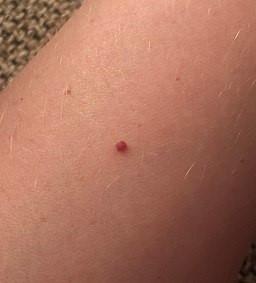Campbell de Morgan spot
Peer reviewed by Dr Toni Hazell, MRCGPLast updated by Dr Rachel Hudson, MRCGPLast updated 31 Oct 2024
Meets Patient’s editorial guidelines
- DownloadDownload
- Share
- Language
- Discussion
Medical Professionals
Professional Reference articles are designed for health professionals to use. They are written by UK doctors and based on research evidence, UK and European Guidelines. You may find one of our health articles more useful.
In this article:
Synonyms: cherry haemangiomas, senile angiomas
Continue reading below
What are Campbell de Morgan spots?
Campbell de Morgan spots, also known as cherry angiomas, are common, benign skin lesions of middle to older age, formed by proliferating, dilated capillaries and postcapillary venules. They are named after an English surgeon, Campbell de Morgan (1811-76).
Causes of Campbell de Morgan spots (aetiology) 1 2
Their cause remains unknown:
Single studies have reported increased incidence in tropical climates, diabetes, transplant patients and those who are immunocompromised.
Pregnancy and prolactinomas are associated with the development of lesions, implicating hormonal mediators.
Numbers increase with age, so factors associated with the ageing process may be relevant.
Chemical exposure (mustard gas, 2-butoxyethanol) causes multiple lesions to develop.
Continue reading below
How common are Campbell de Morgan spots? (Epidemiology)1 2
These are the most common cutaneous vascular proliferation. Few reports have been published recently but it is thought as many as 75% of those over 75 years old may have them.
They increase in frequency and size with age.
They increase in frequency from the age of 40.
They may occur anywhere but are most commonly found on the trunk.
They are seen across all races and sexes.
Visual appearance
Cherry angioma on adult's arm

By Midasblenny, CC BY-SA 4.0, via Wikimedia Commons
1-3 mm diameter macules which may become larger papules over time.
Typical bright cherry red colour but can appear blue or purple.
They are non-blanching.
Continue reading below
Presentation
They usually occur on the trunk and upper extremities.
They can be found at any skin site except the mucous membranes. The scalp has been reported.1
Lesions may be widespread, especially in the elderly.
They are usually asymptomatic.
Differential diagnosis
The diagnosis is usually clear clinically. Differential diagnosis may include:
Angiokeratoma.
Venous lakes (blue angiomas most often on the lips).
Campbell de Morgan spots management
Reassure - these lesions usually require no treatment.
Very occasionally removal may be required if the lesions catch, or for cosmetic reasons.
If removal is desired, treatment options include curettage, pulsed dye laser, electrocautery and excision.
Sclerotherapy has also been found to be effective.3
When to refer
When there is diagnostic uncertainty.
When assistance with removal is required.
Prognosis
Campbell de Morgan spots are benign lesions.
Problems only arise when lesions are frequently traumatised, continue to enlarge or are of cosmetic concern to a patient.
Further reading and references
- Senile Angioma; DermIS (Dermatology Information System)
- Higgins JC, Maher MH, Douglas MS; Diagnosing Common Benign Skin Tumors. Am Fam Physician. 2015 Oct 1;92(7):601-7.
- Angioma (acquired) - including cherry angioma / Campbell de Morgan spots; Primary Care Dermatology Society (PCDS)
- Kim JH, Park HY, Ahn SK; Cherry Angiomas on the Scalp. Case Rep Dermatol. 2009 Nov 11;1(1):82-86.
- Angiomas; DermNet NZ
- Jairath V, Dayal S, Jain VK, et al; Is sclerotherapy useful for cherry angiomas? Dermatol Surg. 2014 Sep;40(9):1022-7. doi: 10.1097/01.DSS.0000452631.83962.58.
Continue reading below
Article history
The information on this page is written and peer reviewed by qualified clinicians.
Next review due: 30 Oct 2027
31 Oct 2024 | Latest version

Ask, share, connect.
Browse discussions, ask questions, and share experiences across hundreds of health topics.

Feeling unwell?
Assess your symptoms online for free